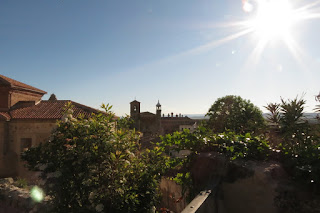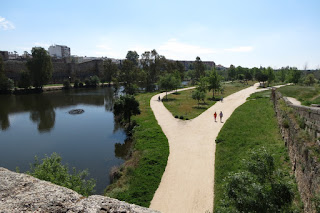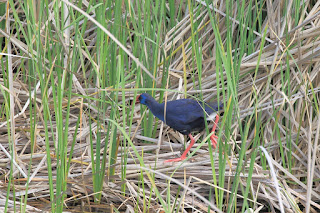 |
| Monfrague vultures |
Extremadura has been praised by
many people I’ve come across in my birdwatching time and now I had the
opportunity to go along with twelve of the group members. On 24th April 2016 thirteen of us
flew to Madrid arriving without hitch at about 8.30pm, and were met by our
guides William Haworth and Juan Pablo Prieto Clemente who whisked us off to our
hotel in the medieval town of Trujillo, a three hour drive away. We went straight to bed after checking in
anticipating what the next few days would bring.
Day 1
 |
| Trujillo tower |
After breakfast there was a
little time to walk to the castle at the top of the hill where our hotel was
situated and survey the surrounding landscape. White Stork
nests were on many of the rooftops, Swift,
Common and Pallid screeched around together with Swallows and a few Crag
Martins. Spotless Starlings and House
Sparrows sat on the roof tops, the former having a lovely repertoire of
mimicry including Greenshank! Our first Lesser Kestrels were spotted and we picked up the first of many Serins.
 |
| A coffee stop |
The main trip today however was
to the nearby plains of Trujillo and Caceres.
The habitat here is known as the Dehesa and is common in
Extremadura. The pasture is planted with
Holm and Cork Oaks. The Holm Oaks are
pollarded for charcoal and the Cork Oaks stripped of their cork about every
nine years. The pasture is grazed by livestock and in the autumn fallen acorns
are eaten by pigs which then produce the most delicious hams. Getting off the bus we could hear the call of
the ubiquitous Corn Bunting. We were to hear and see so many, it’s a pity
that they are in such decline in the UK.
 |
| Gt spotted cuckoos |
Various stops were made along the
roadside and it soon became clear that singing
Nightingales,
Woodchat
Shrikes,
Cettis Warblers were
common. We also saw the first of many
Hoopoes, although try as he might Neil
was unable to catch them on his camera.
Sorry Neil. We were treated to a pair of
Great Spotted Cuckoos early
on and the treats continued throughout the day, seeing our first
Griffon and
Black Vultures (but more of them tomorrow),
Montagu’s Harriers, a
Golden
Eagle and
Great and
Little Bustards,
Calandra and
Short Toed
Larks to name but a few. Pairs of
Rollers and
Lesser Kestrels sat perched on the telegraph wires next to nest
boxes erected especially for them.
By
the end of the day our jaws were aching due to constant ‘grinning like Cheshire
cats’. We were elated and wondered how
the coming days could possibly equal the first!
Day 2
Our next day was spent in the
mountainous Monfrague National Park where the rivers ‘Tajo’ and ‘Tietar’
converge. Only a small part of the park
is open to the public but the open areas give you all the best birds. After a brief comfort stop at Villa Real de
San Carlos (the sight where the Extremadura Bird Festival is held) we headed up
the valley to our first viewing spot.
The rocky cliff opposite held many
Griffon,
Black &
Egyptian Vultures.
 |
| Nightingale |
 |
| Black vulture |
From this
close range it was easy for the uninitiated to separate the different species
with ease. Eagles were also enjoying the
thermals and we were able to see
Short
Toed,
Iberian Imperial,
Booted and
Bonelli’s Eagles. On our
side of the valley close to us we also had amazing views of a
Nightingale singing out in the open,
Blue Rock Thrush and
Rock Bunting. A pair of
Black Storks were nesting on the other side of the valley.
 |
| Black stork nest |
 |
| Short toed eagle |
 |
| Vulture nests |
 |
| Roller |
 |
| Rock bunting |
 |
| Castillo lookout |
 |
| Castillo |
 |
| Chough |
Other stops were made at various viewing
points but our final stop of the day was at Castillo de Monfrague. At the start of the steep climb up the steps
a pair of
Chough called
overhead. At the top eye level viewing
of
Griffon and
Black Vultures was possible and the views across the dehesas to the
south were vast and stunning.
 |
| Griffon |
Day 3
We spent the afternoon in the
nearby Cornalvo National Park. I haven’t
mentioned the wild flowers before now but following a cold and wet spring the
countryside was lush and green and carpets of wild flowers adorned the
fields. Spanish Lavender, Oxeye Daisies, Corn Marigolds
, Vipers bugloss, Poppies and Orchids were in abundance. It was truly beautiful. After lunch we had a walk by a reservoir with a selection of birds including
Azure
Winged Magpies,
Spanish Sparrows
and
Little Ringed Plovers. We then moved on to the Ruta del Rigidero
hide over-looking some wetlands and here we had great views of nine
Spoonbills,
Great White Egrets, a couple of
Bee-eaters and
Black Winged
Stilts.
Quails were also heard
here.
 |
| Spanish Sparrow |
~And hey something different not a bird lizards!!

 |
| Black winged Stilts |
Day 4
Our day started in Trujillo at
the town bullring and yes it is still used but according to William the bull
fighting is dying out, less people attend and attitudes are changing. Here’s
hoping! I felt a little uneasy being
here but we didn’t go inside. The reason
for coming here however, was to see the Lesser
Kestrels for which nest boxes had
been provided on the outside of the building.
 |
| Lesser kestrels |
Moving on and heading for the
Alcollarin reservoir we had a few stops, one by a small stream where we could
hear Golden Orioles around but they were not being co-operative! A
Grey
Wagtail was a new bird for us here.
The next stop was to the site of a
Bonelli’s
Eagles nest on a craggy hillside. We
did manage a sighting along with the many other raptors that we were becoming
accustomed to. Next a stop at a river for a
Great Reed Warbler which gave
great views and song ‘karra karra karra krie krie krie etc. A little further along the road Lesser
Kestrel nests had been built in to the roof space and walls of the local church
and we watched them coming and going for a little while.
 |
| Gt reed warbler |
Eventually we moved on to Alcollarin
Reservoir and had a quick scan of the birds on the water from the
boardwalk.
Common Sandpipers were playing along the dam wall and a family of
Egyptian Geese swam in convoy across
the water, eventually we dragged ourselves away for lunch at the adjacent
picnic tables.
I should mention that
every day except one, we were joined at lunchtime by William’s wife Ana and
their almost one year old Golden Retriever Rasta. Ana provided wonderful picnic lunches and we
looked forward with anticipation to their visits.
 |
| Linda and Rasta |
On this particular occasion though lunch
lunchtime was going to be extra special.
Whilst eating our lunch Rhodie and I noticed what appeared to be a bird
of prey fly in to the tree opposite causing panic amongst the
Sparrows. Sometime after I heard a noise and looked
upwards into the tree above our picnic table.

Momentarily, I thought has someone placed a cuddly toy in the branches
above?
When realisation dawned on me my jaw dropped as we were being looked down on by a Long Eared Owlet. It was one
of the parents that had flown into the tree opposite. When William noticed that we had already seen
‘today’s surprise’ he came over and told us to carry on as normal and not to
look at it too much. Later we viewed the
nest at a distance through a scope and there were two more owlets in the nest
and possibly a fourth in the brood. What
can I say truly wonderful. The day was
not over yet though and we carried on to other parts of the reservoir having
great views of
a Bee-eater colony,
Gull-Billed Terns, a
Ruddy Shelduck and
Black Necked Grebes.
 |
| Juan Pablo and farm dog friend |
Day 5

All packed up and ready to go
home later in the day, we said our goodbyes to Trujillo, the lovely town where
we were staying and which was about to host a local cheese festival, including
500 cheeses over the next few days.
Unfortunately it did not open until 12pm.
 |
| Pizarro |
 |
| Day break |
 |
| Santa Maria la mayor church |
 |
| View from castle |
 |
| Trujillo castle : The castle is in the highest part of Trujillo. It was built in the 13th century on the site of an old Arab fortress from the 9th or 10th century. The square towers typical of Islamic military architecture are preserved. It is built of masonry and mortar and is made up of two parts, the Main Courtyard and the Albacara. |
Our first stop was at Miravet on a hillside woodland to look for Firecrest, Woodlark and Crested Tit. We all had good views of
Woodlark, a few had a brief glimpse of
Crested Tit but although Firecrest was heard it could not be seen!
 |
| Miravet Monfrague 666 metres |
Moving on to Saucedilla and the
Arrocampo Reservoir we picked up our first
Sand
Martin of the trip on the wires at the entrance to the reserve. The highlights here were more
Little Bittern sightings, a
pair of
Red Crested Pochards, and a distant
Black Winged Kite.
 |
| Booted Eagle |
During
lunch back at the visitor centre a
Booted
Eagle came down low over our heads sending all the swallows into a
frenzy. A further couple of hours were
spent here after lunch eventually catching up with a
Savi’s Warbler which gave excellent views. A great end to this trip which exceeded all
our expectations. At around 4pm we
headed back to Madrid to catch the 9pm flight home but that is another story!!!
 |
| A long trip home -being taken to our overnight hotel after our flight was cancelled! |
Ann Tomo
Pictures: Neil Prendergast & Laura Bimson























































